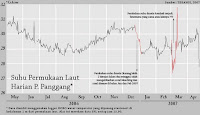Source: Terangi (The Indonesian Coral Reef Foundation)
Coral bleaching in Seribu Islands were encountered twice, in February 2006 and February 2007. This phenomena is highly correlated with drastic temperature change (either increasing or decreasing) in a short period. Temparature change is expected to happen every year. The phenomena started when sea surface temprature increased and followed with bleaching to corals which vulnerable to environmental stresses. if the condition become better, corals will recover. If not, white syndromes caused by bacteria will infect them. This disease can not be prevented, and only in a short time (1-2 months), all colony will die. If the phenomena persist and not handled well, biodiversity loss is inevitable.
February 2006: Survey was conducted on 20th February 2006, it was bright, the sea was calm and hot, but two week earliear an oil spill happen. Fishes, clams, and other benthic organism found dead. The island with the highest impact is Belanda Island. Coral colonies from genera Acropora, Pocillopora, Galaxea, and Porites were infected with bleaching and diseases. In April 2006, about 3,9% of hard corals experienced bleaching and 3,9% infected with white syndromes. This phenomena usually happened in the shallow area (1-5) meters and infected 16 genera especially Acroporids and Pocilloporids (Estradivari & Yusri, 2006).
February 2007: Survey was conducted on 7th February 2007 around the cape of Harapan Islands. Bleaching spread to 50% of the coral cover, which occur in 2-6 meter depth. Genera affected includes Acropora, Pocillopora, Stylopora, Merulina, Porites, and Seriatopora (TNKpS, 2007)
Below is the sea surface temperature fluctuation from May 2006 to April 2007

Tidak ada komentar:
Posting Komentar